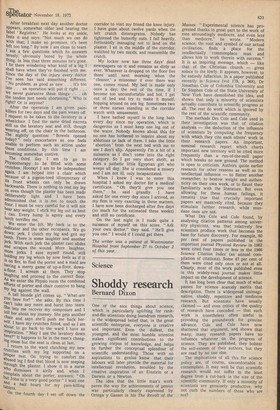Science
Shoddy research
Bernard Dixon
One of the nice things about science, which is particularly uplifting for rankand-file scientists doing humdrum research, is the widespread belief that, in the great scientific enterprise, everyone is creative and important. Even the dullest, the youngest, and the most humble scientist makes significant contributions to the growing corpus of knowledge, and helps to further the conceptual splendour of scientific understanding. Those with no aspirations to genius know that their labours will later provide the material for intellectual revolution, moulded by the creative inspiration of an Einstein or a Darwin or a Newton.
The idea that the little man's work paves the way for achievements of genius was particularly clearly expressed by Ortega y Gasset in his The Revolt of the Masses. "Experimental science has progressed thanks in great part to the work of men astoundingly mediocre, and even less than mediocre," he wrote. "Modern science, the root and symbol of our actual civilisation, finds a place for the intellectually • commonplace man and allows him to work therein with success." It is an inspiring message, which — like that of the Christian church — gives solace to the lowly. It appears, however, to be entirely fallacious. In a paper published recently in' Science (vol 178, p 368), Dr Jonathan Cole of Columbia University and Dr Stephen Cole of the State University of New York have demolished the idea, and shown that only a minority of scientists actually contribute to scientific progress at all. The rest do work which is ignored by the rest of the scientific community.
The methods Drs Cole and Cole used in their investigation was that of citation analysis — the deduction of the influence of scientists by computing the frequency with which they cite each others' work in their research papers. An important, seminal research report which charts important new territory will be cited more frequently than a run-of-the-mill paper which breaks no new ground. The method is open to criticism. Authors quote earlier research for other reasons as well as its intellectual influence — to flatter another researcher, to bestow weight and authenticity on their own work, or to flaunt their familiarity with the literature. But even allowing for these human failings, it remains true that crucially important papers are massively cited, because they stimulate further research, while mundane ones are not.
What Drs Cole and Cole found, by analysing citation patterns among university physicists, was that relatively few scientists produce work that becomes the base for future discovery. For example, 80 per cent of papers published in the important journal Physical Review in 1962 were cited four times or less in the 1966 Science Citation Index (an annual compilation of citations). Some 47 per cent of them were cited only once or not at all. Clearly, most of the work published even in this widely-read journal makes little impact on the development of science.
It has long been clear that much of what passes for science scarcely merits that description. There is widespread unimaginative, shoddy, repetitive and mediocre research. But scientists have usually claimed — and even critics of the quality of research have conceded — that such work is nonetheless often useful in providing the groundwork for genuine advance. Cole and Cole have now shattered that argument, and shown that many, many research papers have no influence whatever on the progress of science. They are published, they bolster the self-esteem of their authors, but they are read by no one else.
The implications of all this for science policy are, of course, uncomfortable to contemplate. It may well be that scientific research would not suffer in the least degree from a cut-back in the size of the scientific community. If only a minority of scientists are genuinely productive, why not curb the numbers of those who are not?


















































 Previous page
Previous page